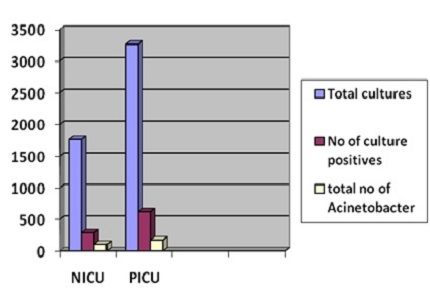Prevalence and resistance pattern of Acinetobacter species in PICU and NICU in a tertiary care Paediatric hospital in Bangalore
Abstract
Objectives: Acinetobacter species are one of the most frequent nosocomial pathogen and can cause a wide range of infections, including bacteremia, pneumonia, urinary tract infection, peritonitis, etc. This organism is becoming resistant to a large group of antibiotics, especially β-lactam antibiotics and also carbapenems.
Aim: To determine the prevalence of Acinetobacter species in the patients of NICU and PICU of a tertiary care paediatric hospital and also to study their resistance pattern.
Materials and Methods: This is a retrospective study done over a period of 12 months from January 2016 to December 2016. The Acinetobacter species isolates by all the clinical samples from NICU and PICU were identified by colony characteristics and biochemical reactions. The resistance patterns of these isolates were identified using various antibiotics by Kirby-Bauer disc diffusion test as per CLSI guidelines .Their antibiogram data and a clinical correlation was made to assess their pathogenic status and mode of acquisition.
Results: Acinetobacter species was isolated in 280(30.7%) samples out of 911(17.75%) culture positive isolates from a total of 5131cultures from NICU and PICU. Maximum isolates were from Tracheal aspirate 93 (57%) followed by pus (52.71%) and blood 88(19.4%). The organism showed high rate of resistance to cefazolin (96.5%) ampicillin (91.8%), amoxyclav (85.2%) ceftriaxone (88.5%), piperacillin (82.9%), ceftazidime (77.5%), amikacin (75.2%) and ciprofloxacin (86.9%). The organism showed moderate resistance to Imipenem(68%) , meropenum (65%) and colistin (60%).
Conclusion: In this study, Acinetobacter species was resistant to many drugs including imepenum and meropenum and there was a significant relationship between patients on mechanical ventilation, length of hospital stay and drug resistance.
Downloads
References
2. Shanthi M, Sekar U. Multi-drug resistant Pseudomonas aeruginosa and Acinetobacter baumannii infections among hospitalized patients: risk factors and outcomes. J Assoc Physicians India. 2009;8(11):687–693.
3. Perez F, Hujer AM, Hujer KM, Decker BK, Rather PN, Bonomo RA. Global challenge of multidrug-resistant Acinetobacter baumannii. Antimicrob Agents Chemother. 2007 Oct;51(10):3471-84. Epub 2007 Jul 23. [PubMed]
4. Peleg AY, Seifert H, Paterson DL. Acinetobacter baumannii: emergence of a successful pathogen.Clin Microbiol Rev. 2008 Jul;21(3):538-82. doi: 10.1128/CMR.00058-07.
5. Hall GS. Non-fermenting and miscellaneous gram-negative bacilli. In: Mahon CR, Lehman DC, Manuselis G, editors. Textbook of Diagnostic Microbiology. 3 rd ed. Philadelphia: WB Saunders; 2007. p. 564-85.
6. Montefour K, Frieden J, Hurst S, Helmich C, Headley D, Martin M, Boyle DA. Acinetobacter baumannii: An emerging multidrug-resistant pathogen in critical care. Crit Care Nurse 2008;28:15-25. [PubMed]
7. Fournier PE, Richet H. The epidemiology and control of Acinetobacter baumannii in health care facilities. Clin Infect Dis. 2006 Mar 1;42(5):692-9. Epub 2006 Jan 26. [PubMed]
8. Richet H, Fournier PE. Nosocomial infections caused by Acinetobacter baumannii: a major threat worldwide. Infect Control Hosp Epidemiol. 2006 Jul;27(7):645-6. Epub 2006 Jun 23. [PubMed]
9. Abbassi M, Rahbar M, Hekmat Yazdi S, Rashed Marandi F, Sabourian R, Saremi M. Evaluation of the 10th External Quality Assessment Scheme results in clinical microbiology laboratories in Tehran and districts. East Mediterr Health J. 2006 May-Jul;12(3-4):310-5. [PubMed]
10. Forbes BA, Sahm DF, Weissfeld AS, editors. Bailey and Scott's Diagnostic Microbiology, 10 th ed. St. Louis: MO, Mosby; 1998.
11. National Committee for Clinical Laboratory Standards. Performance standards for antimicrobial susceptibility testing. Fourteenth informational supplement. Document M100-S14. Wayne, PA: NCCLS, 2004.
12. Rahbar M, Hajia M. Detection and quantitation of the etiologic agents of ventilator-associated pneumonia in endotracheal tube aspirates from patients in Iran.Infect Control Hosp Epidemiol. 2006 Aug;27(8):884-5.
13. Mahgoub S, Ahmed J, Glatt AE. Completely resistant Acinetobacter baumannii strains. Infect Control Hosp Epidemiol. 2002 Aug;23(8):477-9.
14. Al-Tawfiq JA, Mohandhas TX. Prevalence of antimicrobial resistance in Acinetobacter calcoaceticus-baumannii complex in a Saudi Arabian hospital. Infect Control Hosp Epidemiol 2007;28:870-2.
15. Shrivastava G, Bhatambare GS, Bajpai T,Patel KB. Sensitivity profile of multidrug resistant Acinetobacter Spp.isolated at ICUs of tertiary care hospital. Int J Health Syst DisasterManage 2013;1:200-3.
16. M. Anitha, DM. Monisha, A. Mohamed Sulthan, Sathya Pandurangan; Emergence and Prevalence of Acinetobacter baumannii in Tertiary Care Hospital Settings, Sch. Acad. J. Biosci., April 2016; 4(4A):335-341.
17. Mulin B, Talon D, Viel JF, Vincent C, Leprat R, Thouverez M, Michel-Briand Y. Risk factors for nosocomial colonization with multiresistant Acinetobacter baumannii. Eur J Clin Microbiol Infect Dis. 1995 Jul;14(7):569-76.
18. Albrecht MC, Griffith ME, Murray CK, Chung KK, Horvath EE, Ward JA, Hospenthal DR, Holcomb JB, Wolf SE. Impact of Acinetobacter infection on the mortality of burn patients. J Am Coll Surg. 2006 Oct;203(4):546-50. Epub 2006 Aug 24.
19. Rahbar M, Mehrgan H, Aliakbari NH. Prevalence of antibiotic-resistant Acinetobacter baumannii in a 1000-bed tertiary care hospital in Tehran, Iran. Indian J Pathol Microbiol 2010;53:290-3.



 OAI - Open Archives Initiative
OAI - Open Archives Initiative


